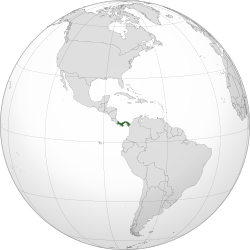Panama
Panama is a country in North America. Its official name is the Republic of Panama, and it's most famous for the Panama Canal. Countries bordering Panama are Costa Rica in the Northwest and Colombia in the Southeast. Panama is between the Caribbean Sea and the Pacific Ocean. Most of the people in Panama are Roman Catholic (about 80%).
Republic of Panama República de Panamá (Spanish) | |
|---|---|
| Motto: "Pro Mundi Beneficio" (Latin) "For the Benefit of the World" | |
| Anthem: Himno Nacional de Panamá (Spanish) National anthem of Panama | |
 | |
| Capital and largest city | Panama City |
| Official languages | Spanish |
| National languages |
|
| Ethnic groups |
|
| Demonym(s) | Panamanian |
| Government | Unitary presidential constitutional republic |
| José Raúl Mulino | |
| vacant | |
| Legislature | National Assembly |
| Independence | |
• from Spain | November 28, 1821 |
• from Colombia | November 3, 1903 |
| Area | |
• Total | 75,517 km2 (29,157 sq mi) (118th) |
• Water (%) | 2.9 |
| Population | |
• January 2013 census | 4,100,000 |
• Density | 542/km2 (1,403.8/sq mi) (156th) |
| GDP (PPP) | 2012 estimate |
• Total | $55.797 billion[1] |
• Per capita | $15,265[1] |
| GDP (nominal) | 2012 estimate |
• Total | $34.819 billion[1] |
• Per capita | $9,526[1] |
| Gini (2009) | high |
| HDI (2013) | high · 59th |
| Currency | (PAB, USD) |
| Time zone | UTC−5 (EST) |
| Driving side | right |
| Calling code | +507 |
| ISO 3166 code | PA |
| Internet TLD | .pa |
Harbors
changeThe Caribbean coastline has many good natural harbors. However, Cristóbal, at the Caribbean terminus of the canal, had the only important port facilities in the late 1980s. The many islands of the Archipiélago de Bocas del Toros, near the beaches of Costa Rica, made an extensive natural roadstead and shield for the port of Almirante. The over 350 San Blas Islands, near Colombia, are spread out for more than 160 kilometres (99 mi) along the sheltered Caribbean coastline.
Demographics
changeThe population of Panama is about 3,405,813 in May 2010. The ethnic makeup of Panama is:
- 50.1%: Multiracial (European, African, Native American, Others).
- 22.0%: Black African (Bantu-Congo 42%, Akan-Igbo 20%, Mandinga-Wolof 20%, Yoruba 10%, Others 8%).
- 6.7%: Native American (Embera, Wounaan, Ngobe bugle, Kuna, Naso, Bribri).
- 8.6%: White European (Spanish-Canarian 74%, German 13%, Italian and Others 13%).
- 5.5%: Asian (Chinese 93%, Korean and Japanese 7%).
- 7.1%: Other.
The information there **Other** is likely including Arabs, East Indians, and some Russian.
For ships, Panama is a flag of convenience.
Economy
changeIn 2011 Panama had an unemployment rate of 2.7%.[4] Panama also had a food surplus in August 2008. Panama was ranked at number 60 on the Human Development Index in 2008.
Panama's economy has experienced an economic boom in recent years. Real gross domestic product (GDP) growth was over 10.4% from 2006 to 2008. The Panamanian economy has been one of the fastest growing and best managed in Latin America. Latin Business Chronicle has predicted that Panama will be the fastest growing economy in Latin America in the five-year period of 2010–14.[5]
Panama is impacted by the global financial crisis. It threatens to damage the social gains made in the past few years.
The expansion project of the Panama Canal and the free trade agreement with the United States is expected to boost and extend the economy.
On April 28, 2022, Panama's lawmakers approved a bill that would legalize bitcoin and other cryptocurrencies. The bill allows using cryptocurrency and trading it, as well as other related topics. It also allowed citizens to use their cryptocurrency to pay taxes.[6]
Provinces
changePanama is divided into nine provinces. Also, there are five Comarcas (literally: "Shires") populated by a variety of indigenous groups.
- Provinces
- Comarcas
References
change- ↑ 1.0 1.1 1.2 1.3 "Panama". International Monetary Fund. Retrieved April 19, 2012.
- ↑ "Gini Index". World Bank. Retrieved March 2, 2011.
- ↑ "Human Development Report 2011" (PDF). United Nations. 2011. Retrieved November 5, 2011.
- ↑ "Panama". CIA – The World Factbook. Archived from the original on December 25, 2018. Retrieved December 23, 2010.
- ↑ Merit Designs (October 7, 2009). "Latin Business Chronicle". Latin Business Chronicle. Archived from the original on July 17, 2010. Retrieved June 26, 2010.
- ↑ Hilaire and Moreno (April 28, 2022). "Panama passes bill to permit use of crypto assets". Reuters.com. Retrieved April 30, 2022.
Other websites
change- Official site of the presidency of Panama (in Spanish)
- Official site of Panama Tourism Archived 2008-05-07 at the Wayback Machine (in Spanish)
- Site of Panama Tourism with videos and photos (in Spanish)
- Pictures from Panama Archived 2006-01-18 at the Wayback Machine
- CoolPanama.com Panama Portal Long list of online radio stations from Panama, also webcams and television stations (in Spanish)
- Panama Travel Guides Archived 2008-11-19 at the Wayback Machine Panama's best attractions, travel guides, news and product reviews

